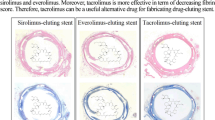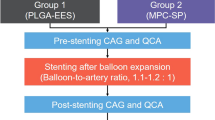Abstract
The drug-eluting stent still has limitations such as thrombosis and inflammation. These limitations often occur in the absence of endothelialization. This study investigated the effects of WKYMVm- and sirolimus-coated stents on re-endothelialization and anti-restenosis. The WKYMVm peptide, specially synthesized for homing endothelial colony-forming cells, was coated onto a bare-metal stent with hyaluronic acid through a simple dip-coating method (designated HA-Pep). Thereafter, sirolimus was consecutively coated to onto the HA-Pep (designated Pep/SRL). The cellular response to stents by human umbilical-vein endothelial cells and vascular smooth-muscle cells was examined by XTT assay. Stents were implanted into rabbit iliac arteries, isolated 6 weeks post-implantation, and then subjected to histological analysis. The peptide was well attached to the surface of the stents and the sirolimus coating made the surface smooth. The release pattern for sirolimus was similar to that of commercial sirolimus-coated stents (57.2 % within 7 days, with further release for up to 28 days). Endothelial-cell proliferation was enhanced in the HA-Pep group after 7 days of culture (38.2 ± 7.62 %, compared with controls). On the other hand, the proliferation of smooth-muscle cells was inhibited in the Pep/SRL group after 7 days of culture (40.7 ± 6.71 %, compared with controls). In an animal study, the restenosis rates for the Pep/SRL group (13.5 ± 4.50 %) and commercial drug-eluting stents (Xience Prime™; 9.2 ± 7.20 %) were lower than those for bare-metal stents (25.2 ± 4.52 %) and HA-Pep stents (26.9 ± 3.88 %). CD31 staining was incomplete for the bare-metal and Xience Prime™ groups. On the other hand, CD31 staining showed a consecutive linear pattern in the HA-Pep and Pep/SRL groups, suggesting that WKYMVm promotes endothelialization. These results indicate that the WKYMVm coating could promote endothelial healing, and consecutive coatings of WKYMVm and sirolimus onto bare-metal stents have a potential role in re-endothelialization and neointimal suppression.






Similar content being viewed by others
References
Pendyala LK, Li J, Shinke T, Geva S, Yin X, Chen JP, et al. Endothelium-dependent vasomotor dysfunction in pig coronary arteries with Paclitaxel-eluting stents is associated with inflammation and oxidative stress. JACC Cardiovasc Interv. 2009;2:253–62.
Joner M, Finn AV, Farb A, Mont EK, Kolodgie FD, Ladich E, et al. Pathology of drug-eluting stents in humans: delayed healing and late thrombotic risk. J Am Coll Cardiol. 2006;48:193–202.
Virmani R, Guagliumi G, Farb A, Musumeci G, Grieco N, Motta T, et al. Localized hypersensitivity and late coronary thrombosis secondary to a sirolimus-eluting stent: should we be cautious? Circulation. 2004;109:701–5.
Seabra-Gomes R. Percutaneous coronary interventions with drug eluting stents for diabetic patients. Heart. 2006;92:410–9.
Hamilos MI, Ostojic M, Beleslin B, Sagic D, Mangovski L, Stojkovic S, et al. Differential effects of drug-eluting stents on local endothelium-dependent coronary vasomotion. J Am Coll Cardiol. 2008;51:2123–9.
Pendyala LK, Yin X, Li J, Chen JP, Chronos N, Hou D. The first-generation drug-eluting stents and coronary endothelial dysfunction. JACC Cardiovasc Interv. 2009;2:1169–77.
Le Y, Gong W, Li B, Dunlop NM, Shen W, Su SB, et al. Utilization of two seven-transmembrane, G protein-coupled receptors, formyl peptide receptor-like 1 and formyl peptide receptor, by the synthetic hexapeptide WKYMVm for human phagocyte activation. J Immunol. 1999;163:6777–84.
Forsman H, Bylund J, Oprea TI, Karlsson A, Boulay F, Rabiet MJ, et al. The leukocyte chemotactic receptor FPR2, but not the closely related FPR1, is sensitive to cell-penetrating pepducins with amino acid sequences descending from the third intracellular receptor loop. Biochim Biophys Acta. 2013;1833:1914–23.
Kwon YW, Heo SC, Jang IH, Jeong GO, Yoon JW, Mun JH, et al. Stimulation of cutaneous wound healing by an FPR2-specific peptide agonist WKYMVm. Wound Repair Regen. 2015;23(4):575–82.
Heo SC, Kwon YW, Jang IH, Jeong GO, Yoon JW, Kim CD, et al. WKYMVm-induced activation of formyl peptide receptor 2 stimulates ischemic neovasculogenesis by promoting homing of endothelial colony-forming cells. Stem Cells. 2014;32:779–90.
Miao Z, Premack BA, Wei Z, Wang Y, Gerard C, Showell H, et al. Proinflammatory proteases liberate a discrete high-affinity functional FPRL1 (CCR12) ligand from CCL23. J Immunol. 2007;178:7395–404.
Lee MS, Yoo SA, Cho CS, Suh PG, Kim WU, Ryu SH. Serum amyloid A binding to formyl peptide receptor-like 1 induces synovial hyperplasia and angiogenesis. J Immunol. 2006;177:5585–94.
Meyers SR, Kenan DJ, Khoo X, Grinstaff MW. Bioactive stent surface coating that promotes endothelialization while preventing platelet adhesion. Biomacromolecules. 2011;12:533–9.
Aoki J, Serruys PW, van Beusekom H, Ong AT, McFadden EP, Sianos G, et al. Endothelial progenitor cell capture by stents coated with antibody against CD34: the HEALING-FIM (Healthy Endothelial Accelerated Lining Inhibits Neointimal Growth-First In Man) Registry. J Am Coll Cardiol. 2005;45:1574–9.
Remuzzi A, Mantero S, Colombo M, Morigi M, Binda E, Camozzi D, et al. Vascular smooth muscle cells on hyaluronic acid: culture and mechanical characterization of an engineered vascular construct. Tissue Eng. 2004;10:699–710.
Travis JA, Hughes MG, Wong JM, Wagner WD, Geary RL. Hyaluronan enhances contraction of collagen by smooth muscle cells and adventitial fibroblasts: role of CD44 and implications for constrictive remodeling. Circ Res. 2001;88:77–83.
Lim KS, Bae IH, Kim JH, Park DS, Kim JM, Sim DS, et al. Mechanical and histopathological comparison between commercialized and newly designed coronary bare metal stents in a porcine coronary restenosis model. Chonnam Med J. 2013;49:7–13.
Bae IH, Lim KS, Park JK, Park DS, Lee SY, Jang EJ, et al. Mechanical behavior and in vivo properties of newly designed bare metal stent for enhanced flexibility. J Indust Eng Chem. 2015;21:1295–300.
Buszman P, Trznadel S, Zurakowski A, Milewski K, Kinasz L, Krol M, et al. Prospective registry evaluating safety and efficacy of cobalt-chromium stent implantation in patients with de novo coronary lesions. Kardiol Pol. 2007;65:1041–6 discussion 47-8.
Seo JK, Choi SY, Kim Y, Baek SH, Kim KT, Chae CB, et al. A peptide with unique receptor specificity: stimulation of phosphoinositide hydrolysis and induction of superoxide generation in human neutrophils. J Immunol. 1997;158:1895–901.
Ma X, Oyamada S, Gao F, Wu T, Robich MP, Wu H, et al. Paclitaxel/sirolimus combination coated drug-eluting stent: in vitro and in vivo drug release studies. J Pharm Biomed Anal. 2011;54:807–11.
Schwartz RS, Edelman E, Virmani R, Carter A, Granada JF, Kaluza GL, et al. Drug-eluting stents in preclinical studies: updated consensus recommendations for preclinical evaluation. Circ Cardiovasc Interv. 2008;1:143–53.
Topol L, Jiang X, Choi H, Garrett-Beal L, Carolan PJ, Yang Y. Wnt-5a inhibits the canonical Wnt pathway by promoting GSK-3-independent beta-catenin degradation. J Cell Biol. 2003;162:899–908.
Heldman AW, Cheng L, Jenkins GM, Heller PF, Kim DW, Ware M Jr, et al. Paclitaxel stent coating inhibits neointimal hyperplasia at 4 weeks in a porcine model of coronary restenosis. Circulation. 2001;103:2289–95.
Seidel CL. Cellular heterogeneity of the vascular tunica media. Implications for vessel wall repair. Arterioscler Thromb Vasc Biol. 1997;17:1868–71.
Meng S, Liu Z, Shen L, Guo Z, Chou LL, Zhong W, et al. The effect of a layer-by-layer chitosan-heparin coating on the endothelialization and coagulation properties of a coronary stent system. Biomaterials. 2009;30:2276–83.
Hou C, Yuan Q, Huo D, Zheng S, Zhan D. Investigation on clotting and hemolysis characteristics of heparin-immobilized polyether sulfones biomembrane. J Biomed Mater Res A. 2008;85:847–52.
Wissink MJ, Beernink R, Pieper JS, Poot AA, Engbers GH, Beugeling T, et al. Immobilization of heparin to EDC/NHS-crosslinked collagen. Characterization and in vitro evaluation. Biomaterials. 2001;22:151–63.
Kim JM, Bae IH, Lim KS, Park JK, Park DS, Lee SY, et al. A method for coating fucoidan onto bare metal stent and in vivo evaluation. Prog Org Coat. 2015;78:348–56.
Vetrovec GW, Rizik D, Williard C, Snead D, Piotrovski V, Kopia G. Sirolimus PK trial: a pharmacokinetic study of the sirolimus-eluting Bx velocity stent in patients with de novo coronary lesions. Catheter Cardiovasc Interv. 2006;67:32–7.
Park S, Bhang SH, La WG, Seo J, Kim BS, Char K. Dual roles of hyaluronic acids in multilayer films capturing nanocarriers for drug-eluting coatings. Biomaterials. 2012;33:5468–77.
Che HL, Bae IH, Lim KS, Song IT, Lee H, Muthiah M, et al. Suppression of post-angioplasty restenosis with an Akt1 siRNA-embedded coronary stent in a rabbit model. Biomaterials. 2012;33:8548–56.
Alfonso F, Dutary J, Paulo M, Perez-Vizcayno MJ. Paclitaxel-eluting balloons for sirolimus-eluting stent restenosis. JACC Cardiovasc Interv. 2011;4:716 author reply 16-7.
Durand E, Scoazec A, Lafont A, Boddaert J, Al Hajzen A, Addad F, et al. In vivo induction of endothelial apoptosis leads to vessel thrombosis and endothelial denudation: a clue to the understanding of the mechanisms of thrombotic plaque erosion. Circulation. 2004;109:2503–6.
Farb A, Burke AP, Tang AL, Liang TY, Mannan P, Smialek J, et al. Coronary plaque erosion without rupture into a lipid core. A frequent cause of coronary thrombosis in sudden coronary death. Circulation. 1996;93:1354–63.
Acknowledgments
This study was supported by a grant of the Korean Health Technology R&D Project (HI13C1527), Ministry of Health & Welfare, Republic of Korea and Basic Science Research Program through the National Research Foundation of Korea (NRF) funded by the Ministry of Science, ICT & Future Planning (2014R1A1A1005948).
Author information
Authors and Affiliations
Corresponding author
Additional information
Eun-Jae Jang and In-Ho Bae contributed equally to this article.
Rights and permissions
About this article
Cite this article
Jang, EJ., Bae, IH., Park, D.S. et al. Effect of a novel peptide, WKYMVm- and sirolimus-coated stent on re-endothelialization and anti-restenosis. J Mater Sci: Mater Med 26, 251 (2015). https://doi.org/10.1007/s10856-015-5585-1
Received:
Accepted:
Published:
DOI: https://doi.org/10.1007/s10856-015-5585-1




